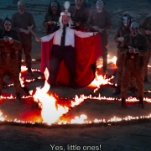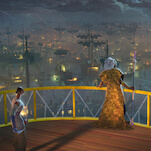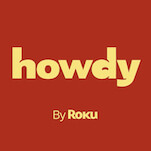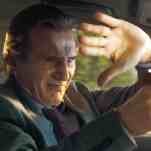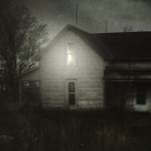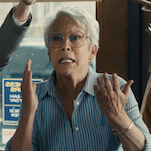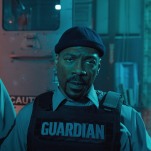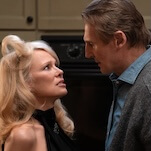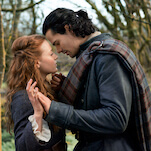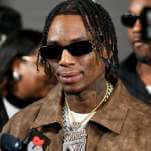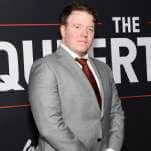How do you come back from the phrase “Based on the Parker Brothers game”? For the 1985 farce Clue, it’s been a long road to cult appreciation. Credit is due partly to ’80s nostalgia and some run-off from the Rocky Horror/Tim Curry midnight camp circuit, but more so to Clue’s overdue acknowledgement as a real movie and not a dumb gimmick of the William Castle school. Released with three endings—viewers would see a different one depending on what theater they attended—Clue tanked at the box office, and was ridiculed by critics who found it labored and silly, and joked about the unlikelihood of audiences paying full admission three times to catch three different endings. Admittedly, the three-ending concept was a guaranteed loser: How do you convince people to come back to a movie for a few minutes of new footage? And how will they be satisfied with the ending they get, when there are two possibly better endings out there? Just basing the movie on a board game was enough to draw suspicion and contempt; adding a big gimmick to the equation was pure hubris.
Though I come mostly to praise Clue, it should be said that the opening few scenes are truly dire. Much of that is owed to the challenges inherent both to whodunits and farces: They need a lot of windup before the pitch. A huge ensemble of characters has to be established. Motives have to be assigned. The various rooms whose doors will be slamming have to be mapped out with careful precision. Whodunits and farces are unforgiving plot machines, because they need to be complicated in order to fool the audience down the line, whether that involves introducing a gallery of rogues, or setting up the dominos that will cascade in act three. It’s an arduous task, and Lynn and his gifted cast do themselves no favors by sweating profusely through it. A running gag about the butler stepping in dog poo is by far the lamest material in the movie, and Lynn makes the mistake of leading with it.
Still, there’s a surplus of narrative business that needs doing, and Lynn (who co-wrote the story with John Landis, a filmmaker who knows his way around classic forms) blows through it as quickly as he can, all while preserving certain elements of the game, like colorful character aliases and the myriad possibilities of who killed whom, in what room, and with what implement. (And envelopes! Oh, the envelopes!) With storm clouds clapping overhead, six strangers convene for a party in a secluded mansion, each greeted at the door by Wadsworth the butler (Curry), who leads them through the evening’s events, and Yvette (Colleen Camp), the sexpot French maid. After assigning them pseudonyms to protect their identities—Colonel Mustard (Martin Mull), Mrs. White (Madeline Kahn), Professor Plum (Christopher Lloyd), Mr. Green (Michael McKean), Miss Scarlet (Lesley Ann Warren), and Mrs. Peacock (Eileen Brennan)—Curry informs his curious guests what they all have in common: For various reasons, they’re currently being blackmailed by his boss, Mr. Boddy, and they’ve been summoned to confront him and turn him over to the police.
Confused yet? It gets murkier. Mr. Boddy shows up, reminds his guests that he still holds their secrets, provides them each with weapons (a knife, a candlestick, a rope, a wrench, a lead pipe, and a revolver), and tells them that killing Wadsworth and destroying the evidence will protect their secrets. The lights go off, there are some shuffling noises, and when the lights come back on, Mr. Boddy lies dead on the floor. Who killed him and with what? Oh yeah, and the cook is dead too, with a knife in her back. And later, a stranded motorist, a cop, a singing telegram girl, and Yvette all bite it, too. Six bodies in total, and everyone’s a suspect.
It’s possible—okay, probable—that I got some of the plot details above wrong, and that’s part of the fun. Clue is so relentlessly, deliberately convoluted that nobody onscreen or in the audience—save perhaps for Wadsworth—can make heads or tails of who killed whom, why, and with what. The bodies just keep piling up as the guests frantically scurry about the house, which of course is rife with secret passageways a killer could slip in and out of—say, the conservatory with a lead pipe, or the billiard room with a candlestick. Like any good farce, Clue keeps on escalating until the escalation itself becomes the central joke, with the characters left manic and breathless and improvising their way through absurd situations. In this giddy sequence, the guests try to cover up the presence of three corpses as a cop inspects the premises:
Clue smartly incorporates elements of the game into a farcical structure that can sustain them and give the whole enterprise surprising legitimacy. It’s true that many of the comic situations, like the one above, are boilerplate, but even those who find Clue manic and unfunny have to admit that it’s a real effort, far more sophisticated in its design than its silly source might have suggested—or deserved. Lynn and Landis are playful with the board-game references—divvying up the weapons like Christmas presents is cheerfully ridiculous, and giant envelopes play a prominent role—but they’re film historians first and foremost, and they use this opportunity to pay grand homage to genres that haven’t been in fashion for decades, if they ever were.
The multiple-endings gimmick got so much attention as a novelty that critics seemed to miss its significance. Now that they’re all collected on DVD, where viewers can watch the endings one after another, it’s clearer that Lynn and Landis were commenting on the arbitrary nature of whodunits. While it’s a fun parlor game for readers or watchers of whodunits to play sleuth and peg the culprit before the big reveal, Clue goofs on the dirty little secret of many whodunits: The “who” could be just about anyone. In spite of the wealth of information that accumulates before the final act, Clue’s creators want the audience to know they could end it however they please, whether it’s one diabolical mastermind behind the whole thing, or a different person for each murder. If you figure out a whodunit, the film implies, you’re lucky rather than good. (For the record, if I were advising people in 1985 on which of the three versions to catch, I’d choose Ending A or Ending C, with Ending B as a distant third.)
Clue is something of a Frankenstein monster, patched together from a board game and a hodgepodge of elements from anachronistic stage and screen forms, and as well as Lynn and his all-pro cast hold it together, it still stomps around in an ungainly fashion, terrifying villagers. (Whoops, lost the analogy there.) There’s no era in which Clue could be considered hip, so it has been left to be adopted by enthusiasts of camp and gaming and comedy of the ancient “Who’s on first?” variety. (See the clip below.) Its adoption by a tiny yet passionate subset of the population is a triumph of nerdkind.
Coming Up:
November 24: Session 9
December 9: Martyrs
December 23: Point Break

